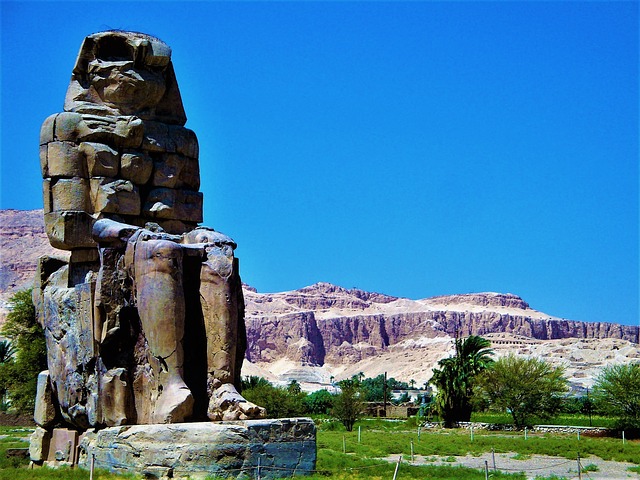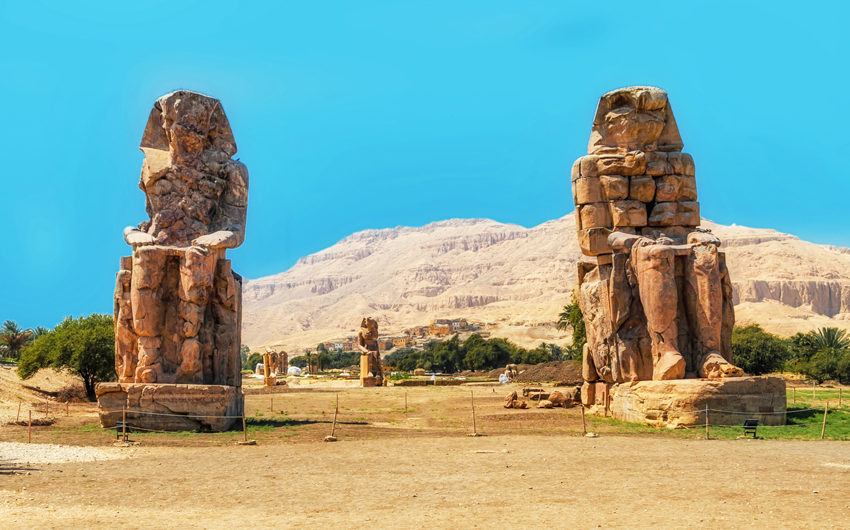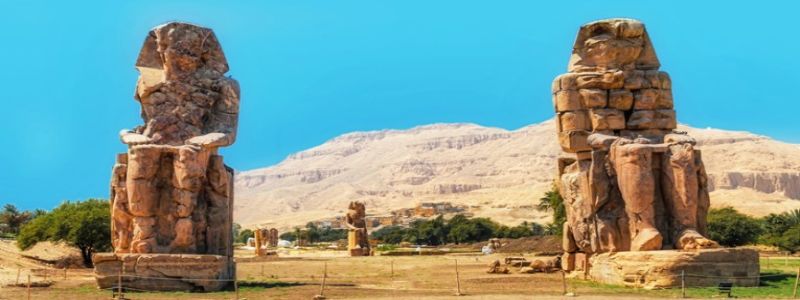Crying colossi of Memnon:
Table of Contents

Egypt monuments have been always amazing for many reasons, one of those is its gigantic statues. The two Colossi of Memnon, originally representing Pharaoh Amenhotep III, rising majestically about 18 meters from the plain, are the first monuments any tourists see when they visit the Nile River’s west bank in Luxor.
Colossi of Memnon’s Location
They are located west of Luxor, the Egyptian city, in Theban Necropolis, where the Colossi of Memnon is one of the most famous and important Luxor Attractions. Before you reach the Antiquities Inspectorate or ticket office, the colossi are just off the road and are almost always being photographed and filmed by an army of tourists. Just a few Kilometre the Nile river runs to give its fertility to the west bank of Luxor.

Description of The Statues
Colossi of Memnon are two enormous monumental stone statues of the Pharaoh Amenhotep III. They depict the king seated on a throne engraved with imagery of his mother, his wife, the god Happy, and other symbolic engravings. They are built out of quartzite stones, which were collected at el-Gabal el-Ahmar since 1350 B.C in Cairo then transported all the way to Luxor. They were built as protectors for Amenhotep’s mortuary complex
The Crying Phenomenon and Legend
To hear the whistling sound emitted by the northern statue at sunrise was considered a sign of good luck by the Greeks and Romans, which they believed to be the call of Memnon greeting his mother Eos, the goddess of dawn. She in turn would shed tears of dew for his untimely death. All this was probably due to a crack in the colossus’ upper body, which appeared after the 27 BC earthquake but the legends still stand.
Who is Memnon?
Memnon is the legendary African king and trojan war hero who led his armies from Africa towards Asia to defend the beleaguered city before he was slain by Achilles.
The Meaning of Colossi
Colossal means a statue that is much bigger than life-size; plural: colossi. The statues were named colossi due to the greek influence at the time, in addition to that, the entire Theban Necropolis was called the “Memnonium”.
Egypt and Amenhotep III

During the period of the New Kingdom from 1570 until 1069 B.C lived the pharaoh Amenhotep III. During that time Egypt became a glorious country of international power and wealth. Ruling at 12 years of age, his father left him a stable empire. Amenhotep was a man of great taste and vision when it came to the land. One of his wonderful palaces is the palace at Malkata, located on the west bank of the Nile near Thebes. This astonishing place holds many rooms, a festival hall, gardens, a lot of libraries, kitchens, conference rooms, and an Amun temple.
The Grand Mortuary Complex
Even from its name, it was the largest and the biggest building that has ever been built in Egypt to that date. It included many rooms, halls, and plateaus, which depicted the vision of the Field of Reeds, the Egyptian paradise.
Though very little of it remains today, The three figures in the statues, Amenhotep III, his wife Tiye, and his mother Mutemwiya are all symbols of rebirth, as so, they have also defied all the natural disasters that they stood through.
What You Can See At Colossi of Memnon
- 2 statues depicting Amenhotep in a seated position.
- Two shorter figures that show Tiye, Amenhotep’s wife, and Mutemwiya, Amenhotep’s mother.
- the whole surrounding area considered a monumental place because it’s so close to the valley of the kings and Hatshepsut temple.
While being in Luxor, you can’t miss the remarkable Colossi of Memnon to be able to see the glory of the Ancients through our Egypt tour packages or Nile cruises presented by “Egypt Story Tours”


Comment (0)